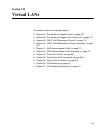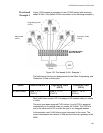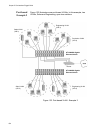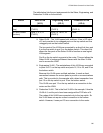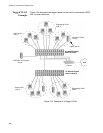AT-9000 Switch Command Line User’s Guide
691
For example, if you had a port-based VLAN named Marketing that
spanned three switches, assign the Marketing VLAN on each switch the
same VID.
You can assign this number manually or allow the management software
to do it automatically. If you allow the management software to do it
automatically, it selects the next available VID. This is acceptable when
you are creating a new, unique VLAN.
If you are creating a VLAN that is part of a larger VLAN that spans several
switches, then you need to assign the number yourself so that the VLAN
has the same VID on all the switches.
Port VLAN
Identifier
Each port in a port-based VLAN must have a port VLAN identifier (PVID).
The switch associates a frame to a port-based VLAN by the PVID
assigned to a port on which a frame is received, and forwards a frame only
to those ports with the same PVID. Consequently, all ports of a port-based
VLAN must have the same PVID. In addition, the PVID of the ports in a
VLAN must match the VLAN’s VID.
For example, if you create a port-based VLAN on the switch and assign it
a VID of 5, assign the PVID for each port in the VLAN to 5.
Some switches and switch management programs require that you assign
the PVID value for each port manually. However, the management
software performs this task automatically. The software automatically
assigns a PVID to a port, making it identical to the VID of the VLAN to
which the port is a member, when you assign the port as an untagged
member to a VLAN.
Untagged Ports You need to specify which ports on the switch are to be members of a port-
based VLAN. Ports in a port-based VLAN are referred to as untagged
ports and the frames received on the ports as untagged frames. The
names derive from the fact that the frames received on a port do not
contain any information that indicates VLAN membership, and that VLAN
membership is determined solely by a port’s PVID. (There is another type
of VLAN where VLAN membership is determined by information within the
frames themselves, rather than by a port’s PVID. This type of VLAN is
explained in “Tagged VLAN Overview” on page 696.)
A port on the switch can be an untagged member of only one port-based
VLAN at a time. An untagged port cannot be assigned to two port-based
VLANs simultaneously.





